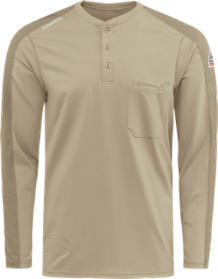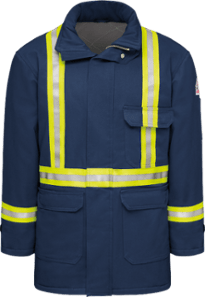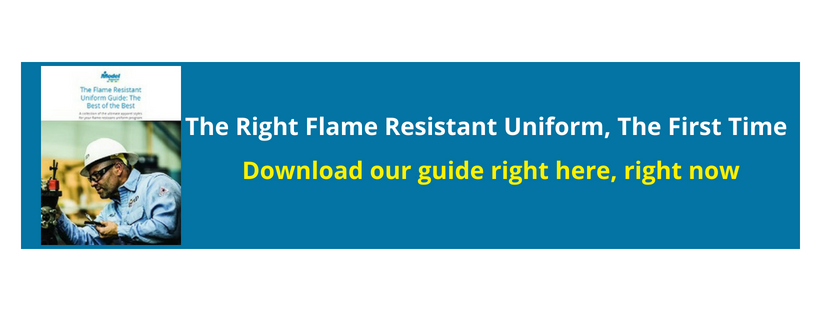If you're relatively local to where we are in Pennsylvania, you know extreme weather. While this winter hasn't been bad, we've had recent winters that have been downright unbearable.
But it's not just winters that can be extreme. Our summers can be extreme as well. We couldn't even imagine summers across the south-west of the United States where deserts are everywhere.
Extreme environments, and their relation to flame resistant clothing, are our topic in this article. Doing harsh work in harsh environments is, well ... harsh. But the folks that work in these environments need some love. We want to support those industries and highlight products for them.
This blog post will discuss the importance of flame resistant clothing in extreme environments. We'll outline the different types of flame resistant fabrics and explain how they work. We'll look at a few harsh environments where you can find flame resistant clothing. We'll also provide tips on how to choose the right type of clothing for the job. So whether you're working in hot or cold environments, be sure to check out our guide before heading to work.
What is flame resistant clothing?
Flame resistant clothing is made from materials designed to self-extinguish when exposed to an open flame. The U.S. Consumer Product Safety Commission (CPSC) defines flame resistant clothing simply. To them, flame resistant clothing is "clothing that is either intrinsically safe or protected against ignition by a barrier material."
There are three general types of flame resistant fabrics: Inherently flame resistant fibers, treated flame resistant fabrics, and barrier flame resistant fabrics.
Inherently flame resistant fibers are those that do not burn or melt. They self-extinguish when you remove the source of the flame. Treated flame resistant fabrics are treated to resist ignition. Their chemical treatment sets them apart. It helps them self-extinguish when you remove the source of the flame.
Barrier flame resistant fabrics are similar to treated fabrics. Barrier fabrics will burn, but they have been laminated with a layer of material. The lamination is inherently flame resistant or treated to be flame resistant.
Choosing flame resistant clothing for an extreme environment is critical. It's important to consider the type of fabric that will best protect you from heat and flames. In general, barrier fabrics offer the best protection, followed by treated fabrics and then inherently flame resistant fibers.
Flame resistant clothing and workplace safety
Flame resistant clothing is an important part of safety in the workplace, especially in extreme environments. OSHA writes that flame resistant clothing has been an integral part of workplace safety since the mid 20th century. Specifically, the early 1970's saw the petroleum refining and chemical processing industries place more value on flame resistant clothing. Employers were starting to emphasize workplace safety concerning flash fire and combustion hazards.
The purpose of this article, though, is to address extreme environments. Flame resistant clothing is critical, regardless of outside temperatures.
Cold environment flame resistant clothing is pretty straightforward. It's big, heavy and stuffed with lined material to help you bear the coldest elements. It's the extreme heat that has brought the latest advancements in flame resistant clothing technology. We're excited to highlight products that are a great fit there.
Extreme environments where resistant clothing is a must
Compressor station
A simple first example of an extreme environment for flame resistant clothing is a compressor station. These buildings house large compressors that help move natural gas from well sites to consumers.
As natural gas moves through the pipeline system, it faces various elevation changes, distance, and friction. These "challenges" reduce pressure and slow the movement of gas. Compressor stations placed along the pipeline system keep gas moving along the supply chain.
While some compressor stations exist outside, a building often protects others. The building helps to reduce noise from the compressor, as well as make it easier to maintain in the elements. These scenarios often classify the environment as extreme. As the compressor runs, excess heat is produced inside the building, increasing the temperature. While these buildings often include ventilation to disperse the excess heat, the buildings can still exceed temperatures of 100 degrees Farenheit.
Railyard
This one might seem strange if you didn't know that we've been transporting liquified natural gas (LNG) by rail car for decades. And when you know that LNG is extremely combustible when introduced to an ignition source, you understand the importance of flame resistant clothing.
Natural gas is an interesting substance. When cooled to below -260 degrees Farenheit, the gas condenses into liquid form. As a liquid, natural gas occupies only 1/600th the volume of it's gaseous state. Once warmed again, the liquid becomes a gas again and a pipe system can transport it. The hazard exists in both forms.
The extreme environment here is pretty clear. Railyards for transporting LNG are outdoors and exposed to all elements. In these elements, heavy and well-insulated outerwear is ideal in colder temperatures. Lighter, moisture-wicking materials are best when temperatures are hotter.
These include environments where there is a risk of an explosion, electrical arc flash, or nuclear radiation. In these environments, it is essential to wear clothing that will not catch fire and will protect you from the intense heat and flames.
Oil rig
A third extreme environment we want to highlight is an oil rig. We consider this environment extreme because of their location. Their location doesn't mean there aren't medical and other necessary facilities nearby. Oil rigs are like floating cities. But that doesn't mean the environment on them isn't extreme.
Some of the most common hazards found on oil rigs are:
- Falls
- Confined spaces
- Machine hazards
- Vehicle accidents
However, flame resistant clothing is necessary because of what the rig is drilling for. Sometimes called oil rigs, these rigs also drill for natural gas as well. When drilling for either of these materials, explosions are possible. Both are highly flammable and flame resistant clothing is designed to protect the wearer from serious burns should an explosion or fire occur.
What makes this environment extreme are the more common hazards. Falls on oil rigs are one of the most dangerous hazards workers face on a rig. It's why personal fall-arrest systems are so important in this environment. Confined spaces often lead to exposure to hazardous chemicals, as well as possible asphyxiation. Unguarded machines like pumps, compressors and conveyors can lead to accidents if the smallest safety details are overlooked.
Now that we've identified what an extreme environment looks like, let's look at some products that are a fit for those environments.
Flame resistant clothing products for extreme environments
When choosing flame resistant clothing for an extreme environment, there are many different products available on the market. Each type of product has its own benefits and drawbacks. It is important to choose the right type of clothing for the job, and to make sure that it fits properly.
We'll break down these products by their usefulness in extreme conditions. First, the best options for extremely hot environments:

Style: Comfort Woven Lightweight FR Shirt with Enhanced Visibility
Colors: Dark Grey
Starting at: $112

Style: Flex Knit Button Down FR Shirt
Colors: Khaki and Navy
Starting at: $92

Style: Flex Knit FR Henley
Colors: Khaki and Navy
Starting at: $82

Style: Comfort Lightweight FR Pant
Colors: Black and Navy
Starting at: $75

Style: Mobility FR Coverall
Colors: Dark Grey and Navy
Starting at: $180
Now, the best options for extremely cold environments:

Style: Fleece FR Hoodie
Colors: Navy
Starting at: $241

Style: Thermal Lined Full-Zip FR Hooded Sweatshirt
Colors: Navy
Starting at: $248

Style: Sherpa Lined FR Vest
Colors: Brown Duck
Starting at: $136

Style: Enhanced Visibility Insulated FR Parka
Colors: Navy and Royal Blue
Starting at: $300
How to buy flame resistant clothing for extreme environments
When buying flame resistant clothing for extreme environments, there are several factors you need to consider. The first is the type of environment you'll be using the clothing in. Each environment has its own risks and hazards, so you need to make sure your clothing is appropriate for the task at hand. For example, if you're working on an oil rig, you'll need different clothing than if you're working in a chemical plant. Regulations for your industry are a great place to start to make sure you're wearing the right clothing.
The second factor to consider is the risks you'll be exposed to. Some environments are more dangerous than others, and you need to make sure your clothing can protect you from the hazards present. There are varying levels of protection that flame resistant clothing provides. Again, checking with regulations in your industry will point you in the right direction.
Next, you need to consider your budget. Flame resistant clothing can be expensive, so you need to make sure you're getting the best value for your money. You can probably find used flame resistant clothing, but you'll definitely want to consider it's condition before you buy it. We've written an article comparing used and new flame resistant clothing. This article should help you decide which is best for your situation.
Finally, consider the best way to buy your flame resistant clothing. Is a local uniform provider available for personal fittings? Will your provider ship a fit line to you if they can't provide personal fittings? Can you easily order everything you need for your team online? These are the first questions to ask when it's time to buy flame resistant clothing.
If you're ready to buy and just want to see a private store demo, use the button below. We're ready to show you how a custom store can help streamline the process of ordering uniforms.
Topics: Flame Resistant
.png?width=621&height=373&name=Model-Apparel%20Logo%20File%20from%20Ian%20(1.2).png)
.png)

